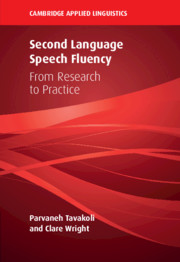Book contents
- Second Language Speech Fluency
- The Cambridge Applied Linguistics Series
- Second Language Speech Fluency
- Copyright page
- Dedication
- Contents
- Figures
- Tables
- 1 Introduction
- 2 Fluency from a Psycholinguistic Perspective
- 3 Measuring Fluency
- 4 Fluency in Second Language Task-Based Research
- 5 Fluency in Second Language Pedagogy
- 6 Fluency in Second Language Testing
- 7 Fluency in Different Contexts
- 8 Conclusion
- Appendix: Fluency Descriptors across Time
- References
- Author Index
- Subject Index
2 - Fluency from a Psycholinguistic Perspective
Published online by Cambridge University Press: 15 December 2020
- Second Language Speech Fluency
- The Cambridge Applied Linguistics Series
- Second Language Speech Fluency
- Copyright page
- Dedication
- Contents
- Figures
- Tables
- 1 Introduction
- 2 Fluency from a Psycholinguistic Perspective
- 3 Measuring Fluency
- 4 Fluency in Second Language Task-Based Research
- 5 Fluency in Second Language Pedagogy
- 6 Fluency in Second Language Testing
- 7 Fluency in Different Contexts
- 8 Conclusion
- Appendix: Fluency Descriptors across Time
- References
- Author Index
- Subject Index
Summary
The chapter focuses on psycholinguistic perspectives of temporal evaluations of fluency, based on skill development, usually comparing L2 fluency to smooth, automatic processes used by native speakers in conceptualising, formulating and articulating speech. We aruge this deficit model of L2 speech is limited, and needs to move to a more dynamic bilingual contextualised view of fluency. We evaluate Segalowitz’s multicomponent model of cognitive fluency, utterance fluency and perceptions of fluency, and current analyses of utterance fluency, in terms of speech rate, breakdown and disfluency, noting how speed, silence and repair may be rated as both negative and positive aspects of fluency. We emphasise the interdependence of individual speech processes across both L1 and L2, the relationship between fluency and different linguistic domains (particularly vocabulary and the role of formulaic sequences or multiword expressions). The chapter also discusses individual differences and psycho-social factors, such as working memory, personality traits, willingness to engage in interaction or not. Also noted are more interactional context-based views of fluency, fluency strategies and perceptions of fluency.
Keywords
- Type
- Chapter
- Information
- Second Language Speech FluencyFrom Research to Practice, pp. 22 - 42Publisher: Cambridge University PressPrint publication year: 2020



